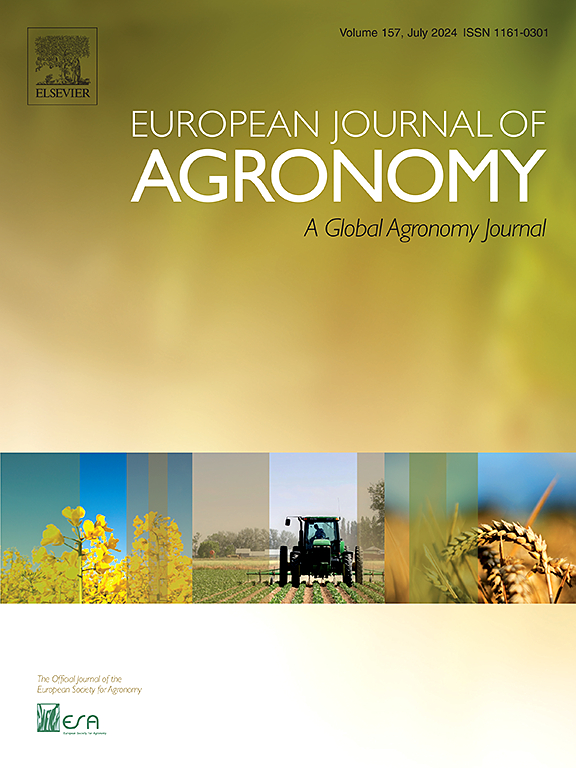An agent-based model to simulate field-specific nitrogen fertilizer applications in grasslands
IF 4.5
1区 农林科学
Q1 AGRONOMY
引用次数: 0
Abstract
Grasslands have a large share of the world’s land cover and their sustainable management is important for the protection and provisioning of grassland ecosystem services. The question of how to manage grassland sustainably is becoming increasingly important, especially in view of climate change, which on the one hand extends the vegetation period (and thus potentially allows use intensification) and on the other hand causes yield losses due to droughts. Fertilization plays an important role in grassland management and decisions are usually made at farm level. Data on fertilizer application rates are crucial for an accurate assessment of the effects of grassland management on ecosystem services. However, these are generally not available on farm/field scale. To close this gap, we present an agent-based model for Fertilization In Grasslands (FertIG). Based on animal, land-use, and cutting data, the model estimates grassland yields and calculates field-specific amounts of applied organic and mineral nitrogen on grassland (and partly cropland). Furthermore, the model considers different legal requirements (including fertilization ordinances) and nutrient trade among farms. FertIG was applied to a grassland-dominated region in Bavaria, Germany comparing the effects of changes in the fertilization ordinance as well as nutrient trade. The results show that the consideration of nutrient trade improves organic fertilizer distribution and leads to slightly lower Nmin applications. On a regional scale, recent legal changes (fertilization ordinance) had limited impacts. Limiting the maximum applicable amount of Norg to 170 kg N/ha fertilized area instead of farm area as of 2020 hardly changed fertilizer application rates. No longer considering application losses in the calculation of fertilizer requirements had the strongest effects, leading to lower supplementary Nmin applications. The model can be applied to other regions in Germany and, with respective adjustments, in Europe. Generally, it allows comparing the effects of policy changes on fertilization management at regional, farm and field scale.
基于agent的草地氮肥施用模拟模型
草原占世界土地覆盖的很大一部分,其可持续管理对于保护和提供草原生态系统服务具有重要意义。如何可持续地管理草地的问题正变得越来越重要,特别是考虑到气候变化,气候变化一方面延长了植被期(从而可能允许集约化利用),另一方面由于干旱造成产量损失。施肥在草地管理中起着重要作用,决策通常在农场一级进行。肥料施用量数据对于准确评估草地管理对生态系统服务的影响至关重要。然而,这些通常无法在农场/田野规模上使用。为了缩小这一差距,我们提出了一个基于agent的草地施肥模型(FertIG)。该模型基于动物、土地利用和采伐数据,估算草地产量,并计算草地(部分农田)施用有机氮和矿物氮的具体农田数量。此外,该模式考虑了不同的法律规定(包括施肥条例)和农场间的养分交易。FertIG应用于德国巴伐利亚州一个以草地为主的地区,比较了施肥条例和养分贸易变化的影响。结果表明,考虑养分交易改善了有机肥的分配,导致Nmin用量略有下降。在区域范围内,最近的法律变化(施肥条例)影响有限。从2020年开始,将Norg的最大施用量限制在170 kg N/ha的施肥面积,而不是农场面积,几乎没有改变肥料的施用量。在计算肥料需要量时不再考虑施用损失影响最大,导致Nmin补施量减少。该模型可以应用于德国的其他地区,并在相应的调整下适用于欧洲。一般来说,它可以比较政策变化对区域、农场和大田规模施肥管理的影响。
本文章由计算机程序翻译,如有差异,请以英文原文为准。
求助全文
约1分钟内获得全文
求助全文
来源期刊

European Journal of Agronomy
农林科学-农艺学
CiteScore
8.30
自引率
7.70%
发文量
187
审稿时长
4.5 months
期刊介绍:
The European Journal of Agronomy, the official journal of the European Society for Agronomy, publishes original research papers reporting experimental and theoretical contributions to field-based agronomy and crop science. The journal will consider research at the field level for agricultural, horticultural and tree crops, that uses comprehensive and explanatory approaches. The EJA covers the following topics:
crop physiology
crop production and management including irrigation, fertilization and soil management
agroclimatology and modelling
plant-soil relationships
crop quality and post-harvest physiology
farming and cropping systems
agroecosystems and the environment
crop-weed interactions and management
organic farming
horticultural crops
papers from the European Society for Agronomy bi-annual meetings
In determining the suitability of submitted articles for publication, particular scrutiny is placed on the degree of novelty and significance of the research and the extent to which it adds to existing knowledge in agronomy.
 求助内容:
求助内容: 应助结果提醒方式:
应助结果提醒方式:


